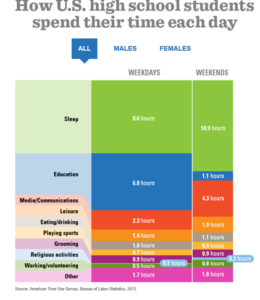Our family’s shared Google calendar is like looking at the racks of paint sample cards at the local hardware store. Each family member has a color and every activity for each person, as far out as it makes sense to put it on the calendar, is on display with colors stacked on top of each other on many of the days. I have to scroll about 2 – 3 months out to see a string of empty afternoons, evenings or weekends. However, these too will be filled up when an ‘updated/official’ schedule is released, or at the point when a family member concludes their winter activity and begins their spring activity and another schedule needs to be entered. This is all without formally accounting for time to work on homework, eating, sleeping and taking care of personal hygiene.

Parents are constantly on the go shuttling their kids to/from activities. It seems traffic patterns get even more congested for parents of middle and high school students. Beginning in the early 2000s there has been increased attention paid to the amount of homework being assigned, examining the number of hours spent on extracurricular activities and the impact on both students and parent alike. What follows are a few starting points to learn more about this research.
The issues related to the amount of homework being assigned is embedded in the larger debates being held on the effectiveness of our education system, the college admissions process and rising expense, and ultimately in the U.S.’s ability to remain competitive on a global scale. One interesting perspective that looks at these factors can be seen in an award winning documentary titled, Race To Nowhere (http://www.racetonowhere.com/). The documentary specifically looks at the outcomes on our student population as policy and social pressures have shaped our educational standards and current behavior as parents. The web site also has a resources area that can serve as a springboard to more information.
Extracurricular activities have shown to improve a student’s academic performance as well as their physical, psychosocial, cognitive functions. Here is a link to an article by the National Federation of State High School Associations that provides an overview of the benefits gained when a student participates in extracurricular activities. However, too much of a good thing can also have a negative effect. There are number of individuals and groups that are studying growing levels of stress, anxiety, depression and sleep deprivation that result from the combination of a student’s academic requirements and participation in extracurricular activities. Jenny Anderson in a qz.com article provides a review of current thinking. Her article also has a number of links to research and the experts who are studying what the right amount might be. Her article can be viewed here.
Finally, Jennifer Senior has been at the forefront researching the effect of children’s activities on their parents. In short, the reciprocal relationship between parent and child that existed in the industrial age and prior to it has shifted. As parents we now work for our children. We work to provide for their basic needs but we also work to make them more competitive. We help them with their homework and projects. We escort them to their parties and social events. We help them go to practices and coaching sessions. We help them with their organizations and club activities, and we help them with their essays and applications. Jennifer Senior points to how a parent’s increased involvement, due to external and internal factors, has impacted a parent’s health and relationships, adding a similar level of stress, anxiety, depression and sleep deprivation to our lives. Her book is titled All Joy and No Fun: The Paradox of Modern Parenthood. You can view a TED Talk that covers the same topic here.
For a large segment of the middle and high school student/parent population it seems we are at a point where there isn’t room to squeeze more academic or extracurricular activities into the time available. We’ve added the extra honors math class or yearbook club to an already packed schedule. What seems to be coming in the near future is a return to the ‘why’ we are engaging in both types of activities. We will begin to see more research and practices that helps build a ‘growth mindset’ in our classrooms as well as refocusing on a host of additional mindset and behavioral standards in the extracurricular activities that students participate in. At that point the reciprocal relationship may be reintroduced, having evolved to look like something quite different that in the past.
